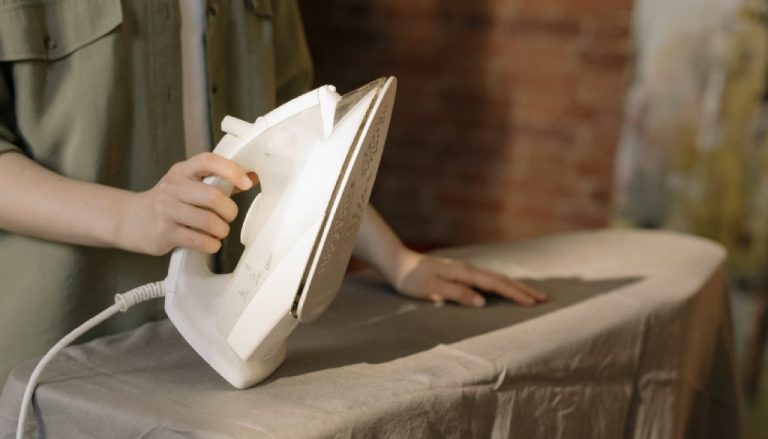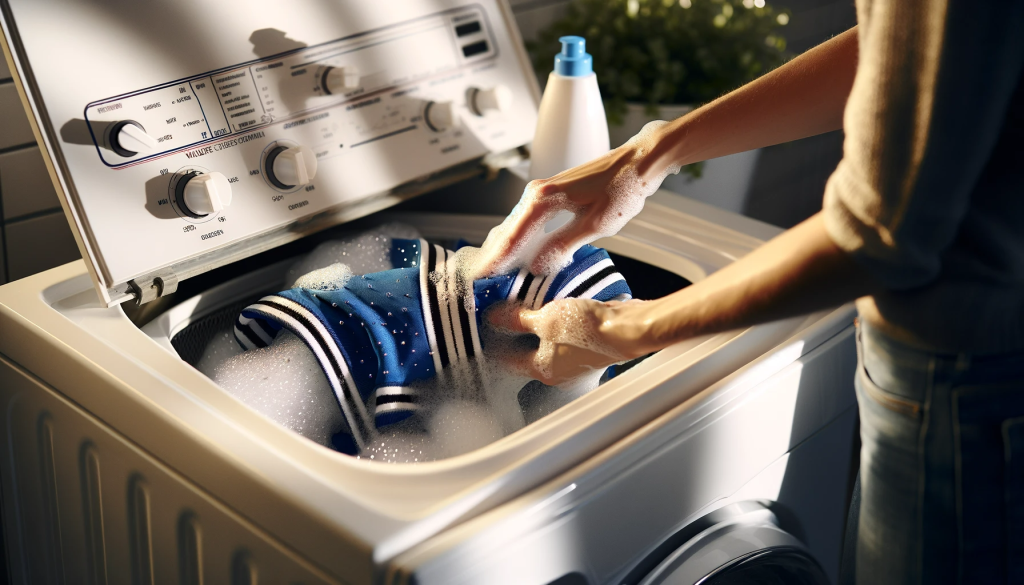Transform your wardrobe and elevate your style with the art of ironing. Discover how mastering this essential skill can rejuvenate your clothing, making each piece look as crisp and polished as the day you bought it. For more on maintaining a sharp, professional look, visit InktasticMerch and explore a range of quality apparel.
Are you finding it difficult to achieve that sharp, pristine look on your newly washed clothes? Ironing is an art that transforms crumpled fabrics into sleek garments. This guide provides a thorough walkthrough, starting from setting up your ironing space to expertly managing various materials.
Embark on a journey to discover the secrets behind flawless, crease-free clothing—it’s easier than you might think!
Key Takeaways
- Choose the correct heat setting for each fabric type: use high steam settings for cotton and linen, and low, steam-free settings for delicate silks.
- Keep essential ironing tools at hand, including a robust board, adjustable iron, spray bottle, pressing cloth, timer, and distilled water.
- Iron garments when they’re slightly damp to simplify smoothing out wrinkles; use a spray bottle to rehydrate dry clothing as necessary.
- Always keep the iron in motion across the fabric, and hang clothes immediately after ironing to prevent new wrinkles.
- Iron safely by testing the temperature on a discreet area of the garment first and selecting irons with automatic shut-off features.
The Importance of Ironing Clothes
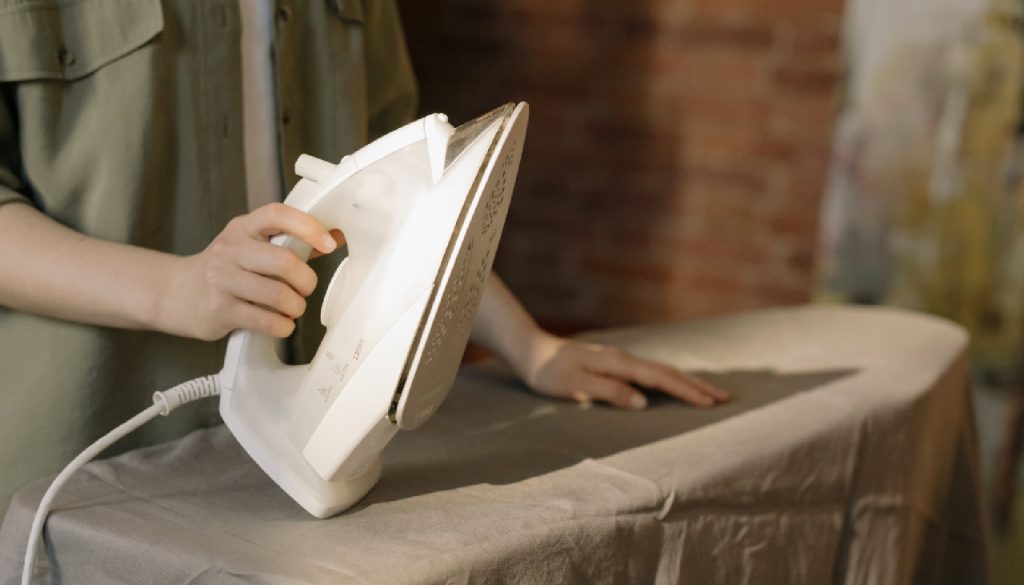
Ironing goes beyond merely flattening wrinkles; it’s a crucial aspect of garment care that elevates the look and feel of your clothes. Wearing tidy, wrinkle-free attire not only boosts your confidence but also ensures you make a positive impression, whether at work or during social gatherings.
Addressing stubborn folds with a hot iron enhances the fabric’s texture and extends the life of your apparel by maintaining its structure over time.
A meticulously pressed shirt collar, sharply creased trousers, and fluid skirts convey an image of detail-oriented professionalism. Utilizing an ironing board effectively removes creases, contributes to the longevity of your clothes, and ultimately saves money by minimizing the need for frequent replacements.
Routine ironing is essential for maintaining your clothes as it keeps fabrics in optimal condition and prolongs their wearable lifespan, delivering a wrinkle-free, polished look that reflects a dedication to personal style.
Steps for Proper Ironing Technique
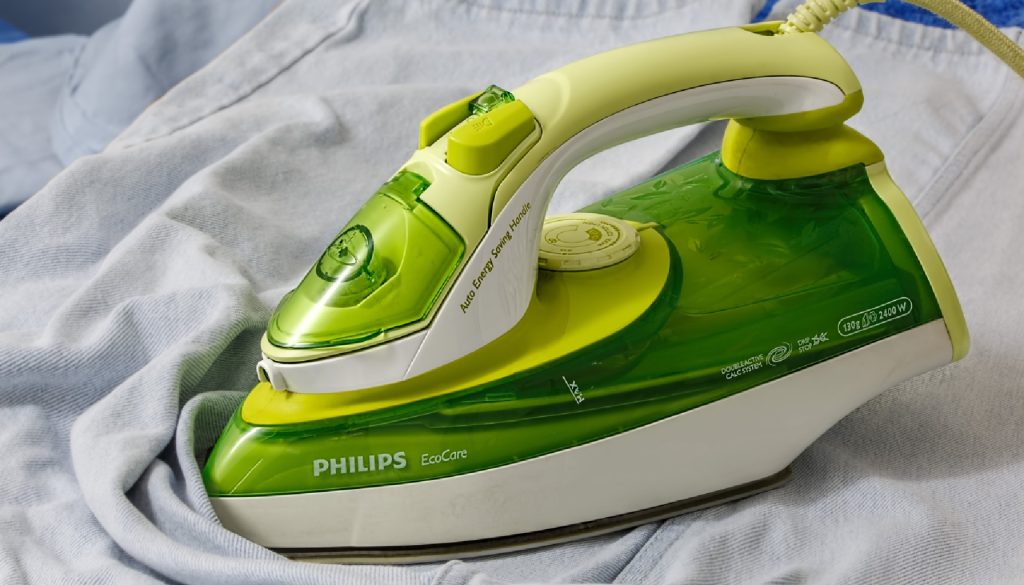
Mastering the craft of ironing is crucial for attaining a crisp, professional appearance in your garments. Explore effective techniques that ensure each sweep of your iron delivers unblemished, wrinkle-free fabric while preserving its integrity—transforming this routine task into a key element of clothing care.
What you need for ironing
Converting wrinkled apparel into refined pieces requires the right tools to achieve a smooth, crease-free finish.
- An iron: Opt for one with adjustable temperature settings and a steam function for comprehensive fabric care.
- Ironing board: A durable, cushioned flat surface enhances ironing efficiency.
- Water spray bottle: Lightly mist clothing to facilitate pressing.
- Pressing cloth: Protect sensitive fabrics from direct heat with a pressing cloth.
- Iron cleaner or descaler: Regularly clean your iron’s plate to remove mineral deposits and maintain peak performance.
- Distilled water: Prevents mineral buildup in your iron, protecting clothes from stains.
- Timer or clock: Monitor ironing time to prevent scorching your garments.
- Hangers or clothing rack: Hang items right after ironing to keep wrinkles at bay.
Starch: Apply to shirts for a sharp, professional look.
Prepare Your Ironing Space
Create an efficient ironing area to transform the task into a quick and enjoyable experience. By organizing your tools and readying the space, you’ll enhance your garment care routine remarkably.
- Select a robust ironing board at a comfortable height to avoid backache.
- Situate your ironing board in a well-lit spot to easily identify wrinkles and folds.
- Ensure the surface is clean and clutter-free to prevent fabric snags or stains.
- Choose an iron with adjustable heat settings to suit different fabrics and avoid damage.
- Fill the steam reservoir for effective wrinkle removal if needed.
- Keep a pressing cloth nearby, especially for delicate fabrics, to shield them from high heat.
- An ironing mat is handy for quick fixes or if space is limited for a board.
- Have a spray bottle with water or ironing spray close to add moisture for smoother ironing.
- Sort your clothes by fabric before starting, optimizing the process and minimizing temperature changes.
Iron While Clothes Are Damp
Ironing slightly damp clothes can dramatically ease the process of removing wrinkles. This method allows the heat to work more effectively, particularly on cotton and linen, which are prone to creases.
A light spray from a water bottle can adequately dampen drier garments. For materials like linen shirts or cotton dresses, pressing them while they still have some moisture lets the heat efficiently handle these fabrics.
Keep your spray bottle nearby for garments that need extra dampness. This slight moisture enables the iron to effortlessly smooth out stubborn wrinkles and press fabrics to crisp perfection without leaving scorches.
This technique not only improves wrinkle reduction but also significantly boosts garment care and longevity. Next, we’ll explore the best approaches for ironing different clothing types and their unique requirements.
Ironing Different Categories of Clothing
Transform your clothes from crumpled to pristine, demonstrating expert apparel care. Using proper ironing techniques tailored to various clothing types ensures they remain flawless without incurring damage.
- Assemble your ironing essentials: the iron, board, and distilled water for steam.
- Create a comfortable, well-lit space with ample room around the board.
- For shirts, begin with the collar, proceed to cuffs and sleeves, then lay flat to press the front and back.
- Align pants at the seams, starting with waistbands and pockets before working down each leg.
- With skirts and dresses, begin at the waist, using circular motions in pleats or designs, carefully reaching the hemline.
- Iron delicate fabrics like silk from the inside out to avoid shine marks.
- Opt for lower heat settings when ironing synthetic fabrics like polyester to prevent fibers from melting or warping.
- Heavier materials such as cotton and denim require higher heat for crisp creases and a polished, smooth look.
Utilizing Steam to Avoid Scorch Marks
Incorporating steam into your ironing routine significantly enhances garment care. It effectively tackles stubborn wrinkles without causing harm, leaving your clothes looking freshly pressed.
- Start by gathering all essentials, including a steam iron, water for the reservoir, and a pressing cloth.
- Use distilled water to fill the iron’s steam reservoir to its recommended level, reducing mineral build-up in the vents.
- Preheat the iron based on the fabric type to prevent scorching.
- Ensure your ironing board is clean and free of debris before laying out the garment.
- Test the steam on a small fabric area or scrap piece to avoid wet spots or discoloration.
- Begin with delicate fabrics like silks and synthetics, gradually moving to durable fabrics such as cottons and linens.
- Apply light pressure to let the steam penetrate and relax the fabric fibers effectively.
- Use a protective cloth barrier for delicate garments prone to shine, adding an extra layer against scorching.
- Maintain a consistent iron movement on one section to prevent scorch marks or burns.
- For clothing too delicate to lay flat, use vertical steaming; hold the garment upright to let steam work its wonders without direct contact.
Mastering the Ironing Technique
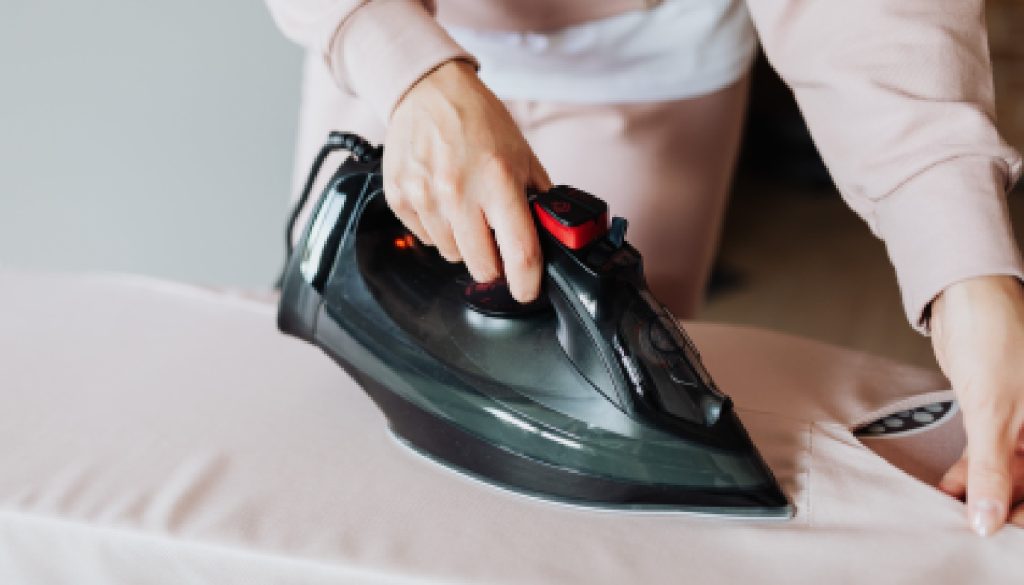
Ironing is more than eliminating wrinkles; it’s an art that enhances your attire’s elegance, showcasing meticulous attention. Master the secret to immaculate garments by skillfully gliding the iron over various fabrics and transforming them into crisply pressed works of art with ease.
Start with the Collar or Neckline
A sharp, professional look for shirts begins from the top. The collar and neckline lay the foundation for the garment’s presentation, making them vital starting points in the ironing process.
- Lay the shirt flat on the ironing board, spreading out the collar or neckline.
- Firmly press down with a hot iron to smooth out creases, moving systematically from one end of the collar to the other.
- Flip over and repeat on the opposite side to ensure both sides are smooth.
- For stiff collared dress shirts, apply extra steam for proper shaping, ensuring not to saturate it.
- Smooth out wrinkles along the seams with firm pressure.
- Adjust your grip to maneuver around buttons without exposing them to direct heat.
- Maintain steady iron movement for an even finish, avoiding any marks.
- Regularly check your progress to prevent overheating and scorching delicate areas.
Work from Top to Bottom
Mastering the art of ironing requires a planned approach, starting with the top of each item and working downward. This strategy helps maintain smoothness in areas already pressed and leads to a more organized process.
- Begin by laying the garment flat on the ironing board, starting at the collar or neckline. Ensure these areas are unbuttoned for shirts.
- Use your hands to smooth out the collar fabric first, then follow up with a gentle press from the iron. Flip it over to ensure both sides have a uniform finish.
- Next, focus on the shoulders and yoke, sliding these sections over the narrow end of the board to keep them flat.
- Iron each sleeve with a firm but gentle hand, paying particular attention to areas like cuffs where wrinkles often persist.
- Continue caring for the garment by ironing the front panels, taking care to navigate around any buttons or embellishments.
- Glide the iron across the garment’s back panel, ensuring new creases don’t form on already-smooth areas.
- Conclude by pressing details like pockets or pleats for a sharp, polished look.
Use Steam and a Damp Cloth
After addressing clothes from top to bottom, let’s explore using steam and a damp cloth to enhance your ironing technique. Steam effectively relaxes fibers, making wrinkles easier to eliminate.
- Choose the right steam iron setting for your fabric to achieve the ideal temperature and steam flow.
- Preheat the iron until it reaches the selected setting to ensure consistent steam production.
- For stubborn wrinkles, utilize the burst-of-steam feature, which offers short, intense bursts for quick smoothing.
- Keep a spray bottle nearby for fabrics that have dried out; a light mist helps reintroduce moisture for ease in wrinkle removal.
- Place a damp cloth over delicate fabrics like wool before ironing to protect them from excess heat.
- Move the iron gently, allowing the steam to penetrate fibers without exerting excessive force.
- Re-moisten the cloth as needed during long ironing sessions to maintain the right level of dampness.
- Allow clothes to fully dry before wearing or storing them to avoid new wrinkles forming too soon.
Ironing Safety Measures
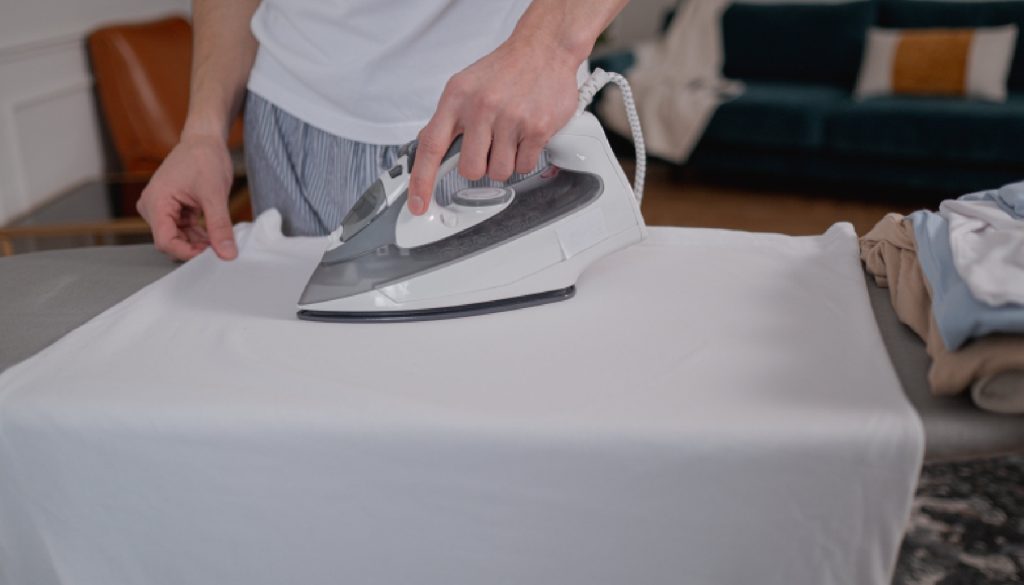
Discover how to safeguard your favorite garments and yourself from heat-related accidents with essential ironing safety tips that ensure a burn-free experience. Stay tuned for expert advice on secure pressing practices.
Tips for Ironing Safely
To iron safely and protect your clothes and yourself, it’s vital to follow these guidelines to avoid accidents or damage.
- Test the iron’s temperature on a hidden part of the garment first to confirm it’s safe for the fabric.
- Ensure your ironing board is stable to prevent it from wobbling or collapsing during use.
- Provide good ventilation in your ironing space to avoid inhaling fabric fumes.
- Opt for an iron with an automatic shut-off feature to minimize fire risk if unattended.
- Avoid leaving a hot iron face down; always place it on its heel or stand when not in use.
- Keep cords untangled and away from the edges of the ironing surface.
board from which it can be accessed.
Understanding iron temperature settings
Acquainting yourself with your iron’s temperature settings is essential for achieving flawlessly smooth clothing without causing damage. Various fabrics demand different heat levels; for instance, cotton can tolerate high temperatures, but ironing them while slightly damp delivers optimal results.
Start with a lower setting and gradually increase the heat, monitoring how the fabric reacts. This method safeguards delicate fabrics from immediate exposure to excessive heat that could potentially spoil them.
Learning to interpret clothing label symbols will aid in choosing the correct temperature, providing crucial insights into fabric heat tolerance and averting instances like scorching or melting fibers.
Mastering these settings equips you with professional-level garment care, prolonging their life and maintaining their best possible appearance. It’s a simplified approach to effective clothing upkeep and wrinkle removal, eliminating the need for guesswork and minimizing risks to your cherished apparel.
How to remove scorch marks
If leaving your iron on clothes leads to scorch marks, fear not; several household remedies exist for this frequent ironing blunder. Begin by preparing a water and lemon juice solution, which often reduces the discoloration from burnt fabric stains.
Apply this mixture gently to the stained area, then rinse with clean water. This straightforward yet effective technique can rejuvenate your clothing without harsh chemicals.
For more stubborn scorch marks, hydrogen peroxide serves as a fabric-safe alternative. Soak a cloth in hydrogen peroxide and dab it on the stain until it starts to lift off the textile—refrain from vigorous rubbing, as it may damage sensitive fibers.
If the iron itself bears scorch marks, cleaning the burns with white toothpaste (avoid gel variants) can help remove them without harming the iron’s surface.
Keep in mind that delicate handling is key during these processes to ensure effective stain removal and fabric preservation.
Tips for Ironing Different Fabrics
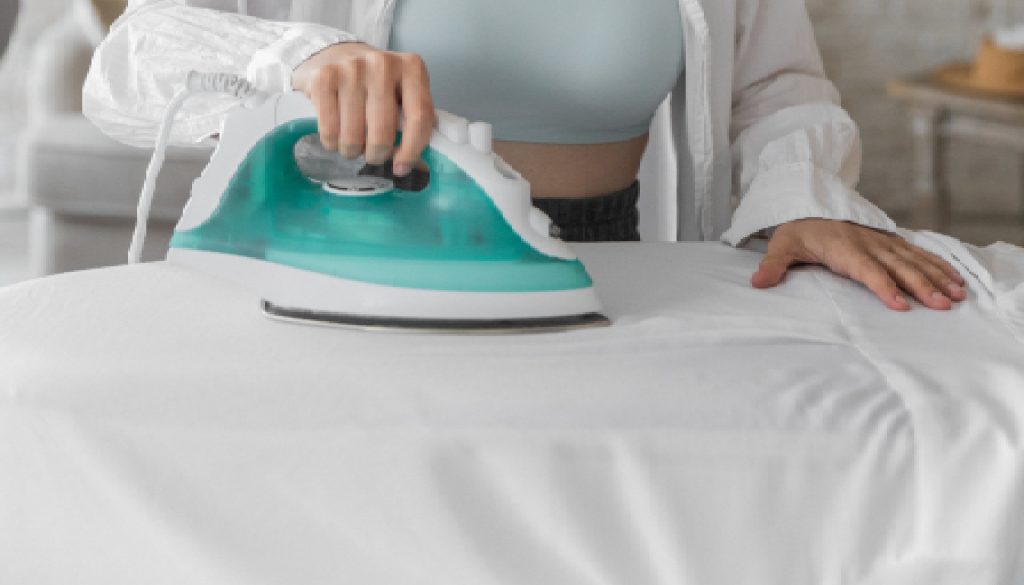
Mastering the intricacies of fabric care is vital to ironing; each material calls for a distinct technique regarding heat and pressure. We’ll explore how to efficiently press various fabrics, from robust cottons to gentle silks, ensuring your attire remains flawlessly smooth while avoiding damage.
Ironing by fabric type
Grasping the specifics of ironing by fabric type is fundamental for garment maintenance. Diverse textiles warrant specific approaches to prevent harm and achieve a polished look.
- Cotton and Linen:
- Wool:
- Polyester and Synthetic Blends:
- Silk:
- Denim and Heavy Fabrics:
- Satin:
- Delicate Fabrics:
Choosing the right temperature for each fabric
Selecting appropriate temperatures for each fabric type is crucial.Each fabric’s care and wrinkle removal are vital aspects of ironing. Irons feature multiple settings designed to match the heat tolerance of various textiles.
- Begin by organizing your clothes according to their ironing requirements, protecting delicate fabrics from excessive heat exposure.
- For fabrics such as acetate, set your iron to 290°F to eliminate wrinkles while avoiding damage.
- Acrylic and nylon can be pressed at a moderate temperature of about 275°F to achieve a smooth finish.
- Heavily wrinkled cotton items require a higher temperature, around 400°F, to achieve a crisp, neat look.
- Linen, which is highly heat-resistant, can be ironed at a maximum setting of about 445°F for optimal results.
- Polyester and silk blends should be handled with their specific heat ranges in mind to prevent melting or burning.
- For wool items, maintain the heat between 275 and 300°F; this is warm enough to address creases softly.
- Silk, due to its fragility, should be ironed at a low temperature between 280 and 300°F to avoid shine or scorching.
- Handle rayon with care by choosing a moderate heat level between 325 and 375°F, ensuring wrinkle removal without deforming its shape.
Tips for Stubborn Wrinkles
Warding off stubborn wrinkles can be challenging, yet it’s manageable with the right ironing methods. Effectively use your steam iron by holding it slightly above the fabric and activating the steam button, releasing hot moisture into the fibers.
This blend of heat and steam unwinds the fibers, simplifying your next steps. Place a lightweight cloth over challenging wrinkles and press firmly with a hot, dry iron in a straight motion for additional heat penetration.
For notoriously resilient wrinkles, repeat the process as necessary, applying gentle pressure to protect the material.
Patience is key when smoothing garments. Allow your iron to methodically erase each wrinkle instead of rushing through. For delicate fabrics, should direct contact prove harsh, hovering above while steaming offers a safer approach—allowing wrinkle removal without jeopardizing fabric care.
Continue gliding your iron across sections until every crease is vanished, leaving crisp and neatly pressed garments ready for wear or storage.
Ironing Delicate Fabrics
Ironing delicate fabrics entails a delicate touch and meticulous care. Segregate these fragile materials from more durable clothing to prevent damage. It’s best to tackle them in smaller areas to preserve their form and integrity.
Handle materials like lace or chiffon carefully to avoid snags or stretching.
For satin, always turn the garment inside out before ironing. Ensure it’s slightly damp and avoid steam to prevent watermarks or harm. Set your iron to the lowest temperature for silk and consider using a pressing cloth for additional protection.
These attentive steps ensure your delicate garments remain immaculate and wrinkle-free without unsightly shine or pressing marks.
Cotton, Polyester, Silk, Wool, and More
Moving from delicate fabrics, understanding how to iron materials like cotton, polyester, silk, and wool is essential, as each demands specific care and precaution during ironing.
- Each fabric type has its ironing rules. Here’s how to handle common textiles:
- Set your iron to a high temperature, as cotton can withstand intense heat.
- Generously use steam to effortlessly eliminate wrinkles.
- Avoid leaving the iron stationary to prevent scorching.
- For polyester, choose a low to medium heat setting due to its sensitivity to high temperatures.
- Apply light pressure and refrain from pulling or stretching the fabric.
- Swift movements with the iron will smooth wrinkles without causing harm.
- Opt for a low heat setting to protect this fragile material.
- Always place a damp cloth between the silk and the iron to avoid direct contact.
- Refrain from spraying water directly on silk, as it can create lasting water spots.
- Set your iron to medium heat for wool items.
- Use a pressing cloth between the iron and your wool garment to maintain its texture and prevent shiny marks.
- Light steam can be beneficial as it helps relax wool fibers.
- Conduct research on specific instructions for unusual or blended fabrics before ironing.
- If unsure about temperature settings or fabric durability, test your iron on an inconspicuous area first.
- Note that items with embellishments or textures may require extra protection, such as using a pressing pad or avoiding direct contact entirely.
Conclusion
Ironing doesn’t have to be a dreaded chore. Equipped with the right tools and techniques, you’ll glide through wrinkles effortlessly. With practice, you’ll soon master the art of pressing clothes like a pro.
Keep these tips in mind for every laundry day; smooth, crisp garments are just an iron away. Your wardrobe will thank you, and looking sharp has never been easier!
FAQs
1. What is the first step to ironing clothes properly?
Begin by setting up your ironing board and preheating the iron to the correct temperature for your fabric type.
2. Can I iron clothes that are completely dry?
Ideally, clothes should be slightly damp, or you can use a spray bottle to lightly moisten them before ironing.
3. How do I prevent my clothes from getting shiny marks when ironing?
To prevent shiny marks, apply a light touch and consider using a pressing cloth between the iron and the garment.
4. Is starch necessary when ironing garments?
While not essential, starch can add crispness and help specific items, like shirts, maintain their shape longer.
5. What’s an effective way to remove wrinkles from delicate fabrics?
Utilize the steam function on your iron or hang the garment in a bathroom during a shower for gentle wrinkle removal without direct heat.
If you found these ironing tips helpful and want to discover more expert advice for mastering everyday tasks, explore our Blog for a wealth of informative articles on a variety of topics.

